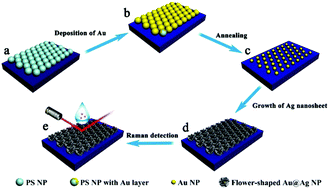Two-dimensional flower-shaped Au@Ag nanoparticle arrays as effective SERS substrates with high sensitivity and reproducibility for detection of thiram†
Abstract
A simple and controllable route is presented for the construction of two-dimensional (2D) flower-shaped Au@Ag nanoparticle (NP) arrays through in situ chemical reduction growth of Ag nanosheets on Au NP arrays. Such micro-/nanostructured arrays composed of interlaced Ag nanosheets can act as good candidates for SERS substrates due to numerous “hot spots” generated by the rough surface of the nanosheets and small nanogaps less than 10 nm between the Au@Ag NPs. After optimizing the experimental parameters (an array periodicity of 500 nm and a growth time of 20 min), the flower-shaped Au@Ag NP array as a SERS substrate has a low detection limit (10−11 M) for thiram, which is a commonly used pesticide molecule and causes environmental pollution due to excessive use. The array also exhibits very good SERS signal uniformity and repeatability (RSD ≈ 7.4%) because of the abundance of “hot spots” and highly ordered structures on a large scale. Such 2D flower-shaped Au@Ag NP arrays with economical preparation and excellent SERS properties are meaningful for the practical applications of organic molecular Raman detection.



 Please wait while we load your content...
Please wait while we load your content...